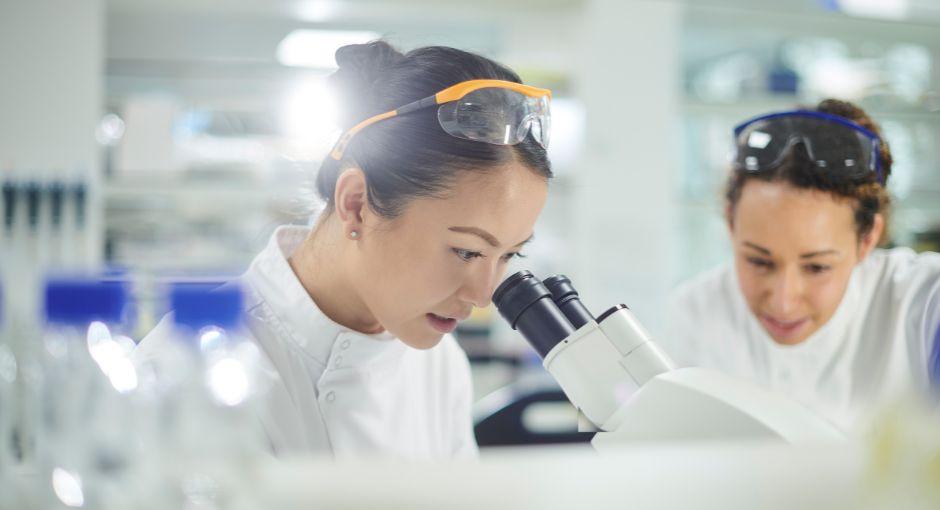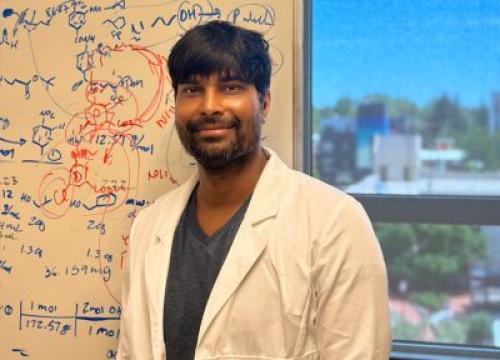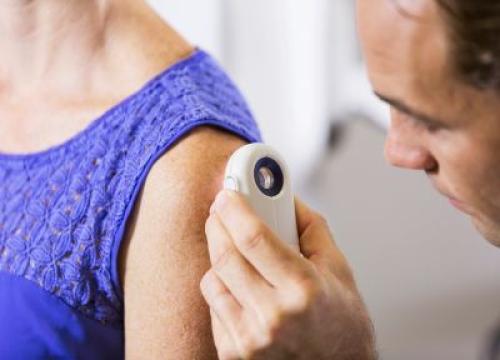Exploring the Potential of Gene and Cell-Based Therapies in Parkinson’s

While still in the developmental stage, gene and cell-based therapies for people with Parkinson’s disease (PD) hold promise to improve quality of life. Learn how researchers hope these therapies might benefit symptom management and slow disease progression.
This article is based on Understanding Gene and Cell-Based Therapies in Parkinson's, a Parkinson’s Foundation Expert Briefing webinar presented by Roger Barker, PhD, Clinical Neuroscience Professor, John van Geest Centre for Brain Repair, University of Cambridge, U.K. Watch the webinar now.
Scientists studying potential gene and cell therapies for Parkinson’s base their work on the understanding that the disease stems from a genetic predisposition that impacts a protein found in brain cells called alpha-synuclein. In people with Parkinson’s, this protein builds up (or misfolds) into clusters called Lewy bodies. When Lewy bodies amass and spread, it leads to the death of dopamine-producing brain cells. Dopamine helps us move, balances moods and influences our emotional health. Once a significant number of these cells have died, a person begins to show the movement symptoms of Parkinson's, such as tremors, slowing and stiffening.
Current Parkinson’s therapies relieve symptoms by replacing lost dopamine through medication and disease management and lifestyle tools, such as exercise and complementary therapies.
New frontiers in PD therapy research include:
- Improved medications to target the dopamine system and treat dyskinesia (involuntary movements of the face, limbs or trunk) associated with levodopa use.
- Experimental closed-loop deep brain stimulation (DBS), in which a DBS system can learn what's happening in the brain and control stimulation applied to the brain to improve symptoms such as dyskinesia.
- Therapies targeting alpha-synuclein through reducing its production, slowing the build-up, or stopping the spread.
There are also various approaches within investigational gene and cell-based therapies targeting PD. Some of these aim to:
- replace lost dopamine
- rescue dying cells
- regrow dopamine-producing pathways
Ideally, a person with Parkinson’s could benefit from new therapies while still utilizing current treatment options. Each area of research — including those aimed at improving symptoms and gene therapies that seek to help the body help itself — tackles different factors of Parkinson’s. In the near future, a combination of cell and gene therapies along with pioneering medications, surgical advancements and lifestyle management might offer the most comprehensive therapy for people living with Parkinson's.
Parkinson’s & Genetics
Genetics cause about 10% to 15% of all Parkinson’s. Dive deeper into how genetics and Parkinson’s are linked.
Examining PD Gene Therapy Approaches
Different companies are pursuing the potential behind various investigational therapies. At the forefront of research are approaches designed to:
- Regrow the dopamine system. This method injects a gene intended to act as a growth factor, or fertilizer, to stimulate brains cells to regrow the dopamine system.
- Replace lost dopamine. This method injects a gene that converts existing cells to produce dopamine. These could replace the need for dopamine-replacement medication.
- Rescue dying cells. New research holds the potential to rescue dying cells, which could offer a path toward disease modification. This type of investigation is designed to interfere with PD and slow progression.
Though still experimental, different strategies have been taken to explore the above types of research over the past two decades with varying levels of success.
Research Aiming to Strengthen the Dopamine Pathway
In 1993, scientists made a pivotal discovery: glial cell line-derived neurotrophic factor (GDNF) — a protein that supports neurons (nerve cells in the brain) — is extremely powerful at regrowing dopamine nerve cells in a lab environment. This led to clinical trials where GDNF was infused into people's brains to try to regrow the dopamine system. The results of these trials are complex, and it is still unclear whether the therapy works.
Another gene therapy program that worked on the same principle was linked to those studies. The program connected neurturin protein (a similar substance to GDNF, though not as powerful) to the AAV2 gene. The investigation studied whether injecting the AAV2-neurturin gene into the area of the brain where dopamine is released would spur cells to take up the gene and promote dopamine fiber growth.
The AAV2-neurturin study went to a double-blind, placebo-controlled trial (participants were randomized, some receiving the treatment while others received a placebo). The study found that:
- At 12 months, there was no difference between those who received neurturin therapy and those who did not.
- At the end of 18 months, people who received the treatment seemed to be doing slightly better, leading investigators to think a successful trial needed more time.
In its second trial, AAV2-neurturin gene was injected into two sites in the brain. After two years, the study showed no therapeutic difference between the trial and placebo groups.
After the GDNF and AAV2-neurturin gene therapies trials, researchers came together to identify what they learned. They concluded such therapies held promise, but recommended future studies take place earlier in the course of Parkinson’s. In the first 1 to 3 years of diagnosis, a person still has several functioning dopamine fibers. These decline rapidly after the first three years. By 5 to 15 years post-diagnosis (the stage most previous trial participants were in) there are few dopamine fibers left.
Today, companies moving GDNF gene therapy trials forward include uniQure and Bayer. Though not gene therapy, Parkinson's UK is pursuing the potential benefits of a protein infusion to boost GDNF levels in the brain.
Can we spur non-nerve cells to make dopamine?
Another PD gene therapy approach is to attempt to infect certain non-nerve brain cells to give them the capacity to make dopamine. There are two main approaches:
- Inject cells to create a synthetic pathway for dopamine in its entirety.
- Give someone enzymes that mediate aspects of the dopamine pathway, along with medication that converts into dopamine.
A ProSavin gene therapy trial relied on a lentivirus as the means to infect cells with pathways that contain the enzymes for making dopamine. Researchers delivered the gene therapy in a single operation on both sides of the brain into the area where dopamine is normally released. They found that using three different doses, delivered in slightly different ways, produced a benefit. However, the benefit was not as effective as DBS and other therapies.
Based on that study, Oxford BioMedica came up with a new gene therapy called OXB-102, which was later bought by Sio Gene Therapies. The study was to have three cohorts of increasing doses, however, the trial was stopped for financial reasons. We cannot draw firm conclusions; however, preliminary research shows the therapy may offer some signs of disease stabilization. Oxford BioMedica now has the license but is not developing the therapy.
Parallel to the above study, U.S.-based Voyager Therapeutics ran a trial using an enzyme associated with making dopamine. Researchers used a similar process — giving different doses to different groups of participants, correctly hypothesizing that giving more gene therapy would induce a bigger response. However, the study was placed on a clinical hold in 2020 by the U.S. Food and Drug Administration when magnetic resonance imaging (MRI) showed unexplained brain abnormalities or changes. That same year, study funding ended to prioritize other research.
- Overall, dopamine gene therapies have yet to be shown to work, but researchers say they continue to hold promise.
On the Horizon: Glucocerebrosidase (GCase) Gene Therapy
A mutated GBA gene (that makes the enzyme glucocerebrosidase) is one of the most common genetic risk factors for Parkinson’s. Up to 10 percent of people with PD have this mutation in one copy of the gene. Researchers believe the GBA mutation can cause enzyme activity to drop, predisposing someone to PD.
A Prevail gene therapy trial currently underway called Propel injects gene therapy into participants with GBA1 Parkinson's. At this stage, the study is evaluating:
- Long-term therapy safety
- Immunosuppression requirements (due to therapy-related inflammation)
- The immune response
- Preliminary effectiveness indicators
Cell Therapies
Every person has about 400,000 to 500,000 dopamine cells. When a person has lost about half of those (200,000 or more) they begin to experience PD movement symptoms. Cell replacement aims to inject new dopamine cells into the brain to replace those that are lost or dying. Such therapy could provide the maximum benefit of dopamine medications with none of the side effects.
Trials have been going on since the late 1980s using human fetal dopamine cells. Around 2007, science developed the capacity to take a human stem cell (a cell that divides indefinitely and can be directed to become any type of cell) and turn it into the type of dopamine cell lost in PD. Allogeneic stem cells are those derived from another human. Autologous stem cells are taken from the person for whom they will be used.
Analysis suggests that younger people with less advanced PD fare better with cell therapy. Tissue preparation prior to implantation, post-graph length of immunosuppression to prevent tissue rejection and long-term follow-up also appear to be important.
Tips for Participating in A Research Study
If you are considering joining a research study:
- Talk to your health care provider to learn about the risks and potential benefits.
- Never pay to enroll or participate in a study. A legitimate study will typically be funded through national funding agencies and non-profits and will never ask participants to pay.
- Explore the Parkinson’s Foundation Fact Sheet Getting Involved in Research to understand how clinical trial work.
- Learn more in our Join A Study article.
Learn More
The Parkinson’s Foundation believes in empowering the Parkinson’s community through education. Learn more about PD and the topics in this article through our below resources, or by calling our free Helpline at 1-800-4PD-INFO (1-800-473-4636) for answers to your Parkinson’s questions.
Related Blog Posts


